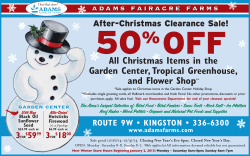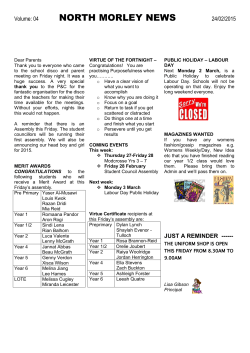
April 2015 Yellowthroat - Oconee Rivers Audubon Society
April 2015 Next Meeting: Thursday, April 2, 7:00 p.m. Sandy Creek Nature Center in Athens For the 7:00 p.m. presentation: Beavers and Us: How We Can All Benefit from Learning to Coexist with This Ancient Wetland Engineer Vol. 26, No. 4 Spring Bird Walks – Think Spring! Bird walks are from 8 a.m.-11a.m. or noon. However, attendees may leave early. Please dress for the weather, wear practical shoes, hats and bring insect repellent and snacks/water as desired. (Also, check ORAS announcements and website for any last minute changes to this schedule). If you have other questions please contact Ed Maioriello at: fieldtrip@oconeeriversaudubon.org Apr. 04: Sandy Creek Park Apr. 11: Lake Herrick/Oconee Forest Park Bob Kobres, an engineer who retired from University of Georgia Libraries, will give a presentation on beavers and their remarkable engineering abilities. Apr. 12: Sandy Creek Nature Center (SCNC) As a long-time advocate for a better relationship between beavers and humans, he will explore the animal’s keystone role in creating and maintaining bird-friendly wetlands Apr. 26: State Botanical Garden (Day Chapel) Besides discussing how beavers “manage” wetlands throughout the Northern Hemisphere, Kobres will demonstrate ways people are devising to mitigate problems that arise as beaver return to areas where humans had eliminated the species through trapping and draining wetlands. Meetings are held…the first Thursday of the month at 7:00 p.m. To get to the Nature Center, take Highway 441, exit # 12, off the north side of the perimeter, go north on 441 approximately one mile, and turn left at the Sandy Creek Nature Center sign displaying this logo: Apr. 18: Whitehall (S.Milledge & Whitehall Rd.) May 02: SCNC-Cook’s Trail (clean-up) (Attendees for the Whitehall walk need to be right on time). Spring Field Trips (out of town) * Apr. 25 6:00 a.m. Kennesaw Mountain May 09 7:00 a.m. Charlie Elliott Wildlife Center * Please check listserv announcements for any late changes. ORAS Conservation Grants – April 15 Deadline for Receiving Proposals Oconee Rivers Audubon Society is soliciting proposals for our conservation grants program which seeks to fund conservation projects, habitat improvement and bird-related research in Georgia. Awards are typically in the range of $300-600. The deadline for receiving proposals is April 15. Go left at the end of this short road. The Education & Visitor Center building is a short way down the road on your right. For more details on the application process, please visit: www.oconeerriversaudubon.org/grant Bluebird Nest Boxes by Brian Cooke Sightings Reported at March Meeting On February 15, a sunny but chilly Sunday, Oconee Rivers American Goldfinch, Purple Finch, Bluebirds, Daniels Bridge Rd., Oconee County, Steve Duke, 2/27/15 Audubon Society (ORAS) volunteers teamed up with the Athens-Clarke County Girl Scouts to build 11 bluebird nest boxes to be installed at local parks. Twenty-five Girl Scouts (and a handful of parents) braved the cold to learn about the importance of bluebird boxes, safe tool use, and nest box construction. Volunteers organized tool stations and helped small groups of scouts with problem solving during box construction. The young girls were enthusiastic about every tool, from screwdriver to hammer to saw. Even the hardships of a hand-drill were fun for the scouts. ORAS volunteers did a great job encouraging and empowering the girls through the building process. This event was perfectly timed to increase nesting opportunities for local, early nesting bluebirds. AthensClarke County park visitors may be quite happy to see new boxes and even happier when the new residents arrive. Rufous Hummingbird, Pine Siskins, Cobb St., Athens, Krista Gridley, 11/14 – current, 2/15 – 3/15 respectively Eastern Towhee, Purple Martins, Tree Swallows, Wilkes Pond on Colham Ferry Rd, Oconee County, Mark Freeman, 3/5/15 Redheads, Green-winged Teal, Old Farmington Rd., Oconee Country, Carole Ludwig, 3/3/15 Sandhill Crane, Salem Rd, Oconee County, Homer Rios, 2/3/15 Greater Scaup, Wilkes Pond on Colham Ferry Rd, Oconee Country, Rachel and Steve Holzman, 2/28/15 These new boxes, much like those used at homes around the area, are side open boxes that need to be maintained regularly. At home, please remember to always clean out old nests before the start of spring to allow space for new bluebird nests. When old nests are not removed, parasites and disease may negatively affect a nesting pair, and nests become more vulnerable to attacks from predators. Monarchs in a Changing World For more information on making bird-friendly habitat and our Backyard Wildlife Sanctuary certification, please visit: http://www.oconeeriversaudubon.org/sanctuary Monarch butterfly populations are in serious decline. Groups such as Center for Biological Diversity and Xerces Society seek federal protection for the Monarch to designate and protect critical habitats and develop a recovery plan. summary of March meeting by Liz Conroy Thanks to Sonia Altizer for her talk on Monarchs. She described their bright coloration as a warning signal to predators. When a bird eats a Monarch, it experiences violent vomiting and never eats an orange butterfly again. Several causes contribute to the Monarch’s decline: illegal logging in their wintering sites in Mexico, climate change and drought, and loss of breeding habitat. About 90% of monarch breeding habitat occurs in agricultural landscapes. Unfortunately, the Monarch seeks milkweed in the corn belt of the U.S. Changes in agricultural practices are devastating. Roundup ready crops (corn, soy, cotton) mean that these genetically modified crops can resist the spraying of glyphosate (a broad-spectrum systemic herbicide). Farmers keep spraying all summer. Monarchs still try to lay their eggs on the milkweeds near cornfields. But with the regular chemical spraying, the breeding plant is wiped out along with the eggs. Another deadly problem for monarch is Ophryocystis elektroscirrha. This protozoan parasite has increased in eastern Monarchs in recent decades. Photo of Girl Scouts and ORAS volunteers by Brian Cooke, Clarke County—February 15, 2015 To help Monarchs, Altizer recommends that people avoid planting tropical milkweed (non-native) and plant native milkweeds. Also, donations to World Wildlife Fund, Monarch Butterfly Fund, and Xerxes Society will help these groups continue their work to protect Monarchs. To learn more about how you can help, please visit: www.worldwildlife.org, www.monarchbutterflyfund.org and www.xerces.org anything with flowers attracts a wide diversity of beneficial insects including pollinators and predators. Gardeners--Protect Predatory Insects! Interview with entomologist Nancy Miorelli* by Liz Conroy 1. What exactly is a predatory insect? A predatory insect is just an insect that eats other insects or other animals. They’re like the cheetahs and lions of the insect world. Mantises will eat other insects and firefly larva will eat slugs and snails. Dragonflies are great because they eat mosquitoes; ladybugs eat little aphids and plant hoppers. 2. What are some of your favorite predatory insects? I have so many! I love mantises because they’re extremely intelligent and have favorite spots where they’ll know they’ll get a lot of food. While strictly not insects, I also have a soft spot for spiders (arachnids). Not only are they beautiful animals, but not all of them spin traditional webs to capture food. Wolf spiders just chase down their prey like cheetah on the Serengeti. Bolas spiders make a silken ball at the end of a line (called a bolas) that has female moth pheromone in it. When a male moth comes over thinking he’s found a mate, the bolas spider will toss the sticky bolas and catch the moth out of the air. 3. 4. 5. How do these insects help gardeners naturally? We always talk about environments or ecosystems on the planetary scale like, “the rainforest” or a “desert”. But gardens are ecosystems too. Your garden is a different ecosystem than your lawn, which is different from the woods, which is different from your living room. Gardens have the same things going on in them as a bigger ecosystem just on a smaller scale. Beneficial predatory insects (and others!) are like the wolves and hawks that control pests from the top down. They eat the things you don’t want in your garden. There are even some beneficial herbivores insects used by farmers to control plants. How do herbicides/pesticides affect these insects? Generally, there are two types of chemicals used to vanquish undesirables. There are broad spectrum chemicals like Roundup for plants and pyrethroids for insects. They do a lot of damage to non-targets since they use a general mode of action to work. For example, pyrethroids are very harmful to bees. Many beneficial species are more sensitive than pest species to insecticides because of their longer lifespan and reproductive cycle. In fact, even in sub-lethal doses, pesticides have been shown to affect the behavior of bees and spiders. Others herbicides and insecticides are very specific and kill only certain target species. For example, Bacillus thuringiensis (Bt) is often used against insects and is readily available. Bt is specific enough to kill caterpillars without hurting their predators. What are some ways to attract and protect them? Planting a wide variety of plants helps attracts lots of different insects. Plants that grow really close to the ground give predatory beetles, like rove and tiger beetles, coverage. Bushes are good for mantises, and If you look carefully, you should see a wide diversity of bees, wasps, flies, and spiders visiting your flowers. If you have a lot of different things visiting your gardens, you have a healthy garden ecosystem. Making sure your garden has good drainage, and regularly dumping out excess water from birdbaths and flowerpots will deter mosquitoes, which are insects that many people try to control with insecticides. Many garden stores will sell beneficial insects, but not all of the insects are native and not all remain in the area of release. It’s best to read about the insects of interest before buying them. 6. Are predatory insects important in the food chain? In your garden alone, you can support at least several hundreds of insect species occupying various levels of the food chain. The predatory insects are at an interesting spot in the food web. They exert top down control on the things eating your petunias and are sources of food for birds and reptiles. Predators in general promote the growth of biodiversity (the number of species present in an ecosystem). Generally the more species, the healthier the ecosystem. Biodiversity spawns competition; it is predation and competition that keep populations in check. 7. What are some good websites and other resources? I recommend “Farming with Beneficial Insects” by the Xerces Society. It has good information and warns consumers about potential risks of buying insects. And, the “Field Guide to Insects and Spiders of North America” by Arthur Evans is really good. My friend and I have a blog “Ask an Entomologist” (www.AskEntomologists.wordpress.com) where we answer questions from the public about insects. Other good blogs include:“The Smaller Majority” (http://thesmallermajority.com/) by Piotr Naskreki “Myrmecos” (http://www.myrmecos.net/) by Alex Wild “Charismatic Minifauna” (http://www.wired.com/category/scienceblogs/charismaticminifauna/) by Gwen Pearson “Beetles in the Bush” (https://beetlesinthebush.wordpress.com/) by Ted MacRae. Facebook groups include: “Entomology” and “The Garden Professor’s Blog.” Also, contact your local University’s extension entomologists, agronomists, and horticulturalists. Phone: 1-800-ASK-UGA1 Email: ugaextension.com *Nancy Miorelli has her Master’s degree in Entomology and loves discussing bugs! Oconee Audubon Society P.O. Box 81082 Athens, Georgia 30608-1082 Return Service Requested A Sad Farewell to Bill O’Grady Non Profit Org. U.S. Postage Paid Athens, GA Permit No. 41 Oconee Rivers Audubon Society by Alison Huff Long-time Oconee Rivers Audubon Society member Bill O’Grady, a cornerstone of the Athens birding community for twenty plus years, passed away on March 5. Bill and his wife Karla moved to Athens in 1994. They were among the first Georgia birders to use eBird in 2004. Their early efforts in recording bird lists from the State Botanical Garden of Georgia (SBG) were instrumental in the SBG becoming a state Important Bird Area. Bill also meticulously entered their backyard data for the last ten years, continuing to do so right up until his last week. He entered more eBird checklists (5,292) than any other Georgia birder has to date. He shared his enthusiasm by introducing eBird to many other birders, including Joel McNeal who currently reviews all Georgia eBird records. President Richard Hall President@oconeeriversaudubon.org Vice-President Brian Cooke vp@oconeeriversaudubon.org Treasurer Alison Huff treasurer@oconeeriversaudubon.org Secretary Mary Case secretary@oconeeriversaudubon.org The Yellowthroat Published monthly by the Oconee Rivers Audubon Society PO Box 81082 Athens, GA 30608 Submit items to address above or e-mail The Yellowthroat editor Liz Conroy: yellowthroat@oconeeriversaudubon.org Articles, artwork, notices, and sighting reports welcomed. The deadline for submissions is the first day of each month. All articles and artwork are copyrighted, and all rights are reserved by the authors. Opinions expressed in articles are those of the respective authors and do not necessarily reflect the official views of Oconee Rivers Audubon S
© Copyright 2025















